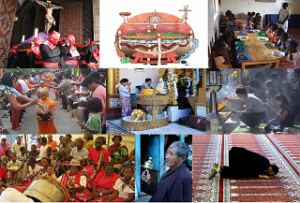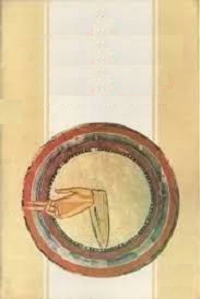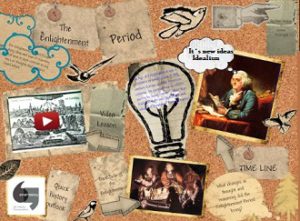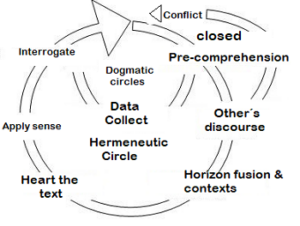
Arquivo para a ‘’ Categoria
Spirituality and Worldview
Spirituality is the search for meaning in life, it can stop at the physis, which for the Greeks was nature, or it can go beyond and contemplate the meta-physis, which means μετα (metà) = after, beyond all; and Φυσις [physis], that is, beyond nature and physics.
the physis, which for the Greeks was nature, or it can go beyond and contemplate the meta-physis, which means μετα (metà) = after, beyond all; and Φυσις [physis], that is, beyond nature and physics.
Thus, a spirituality that stops in nature, the explanation for example of the origin of the universe, even if it is a physical worldview, lacks an eschatological worldview that explains the origin and end of everything, will at some point fall into sophistry and nihilism, as the sophist Gorgias (485-380 BC) nothing exists.
If nothing exists, the meaning of life is meaningless, much is superficially explored the meaning of life, for many it is just being happy, it is still a limited worldview, pain and suffering are part of life, so it is necessary to go through them for the life actually makes sense.
Spirituality needs a worldview, or if you prefer the more philosophical term, a worldview (Weltanschauung), used in an almost opposite way by Kant and Heidegger, while Kant uses it as idealistic transcendence (from subject to object), Heidegger it returns to the metaphysical tradition, with the purpose of distancing itself from it.
The concept of eidos (in Greek is form and essence) transformed into an idea, and the separation of the subject from the object, relegated the questions of the spirit (not even spirituality can be called) to the field of subjectivity, the starting point of the philosophical movement called German idealism it was the publication of the Critique of Pure Reason in 1781 by Immanuel Kant (1724-1804), ending fifty years later with the death of Hegel (1770-1831).
Martin Heidegger starts by questioning the meaning of being of being-there. This is because “this term does not mean only the conception of the connection between natural things, but, at the same time, an interpretation of the meaning and purpose of the human being there and, therefore, of history [Geschichte]” (HEIDEGGER, 2012, p. 13).
Much of what is called spirituality is actually just a search for meaning in life, a mental exercise that is different from the spiritual, lacks an ascesis, a true “ascension”, so it always returns to physis, nature or to the ground.
A complete worldview must go beyond the fact and reach intentionality, everything exists with an intention, to be aware is “to be aware of something”, as Husserl’s phenomenology thinks, so awareness of the “universe” therefore has an intention of the existence of the universe , which is part metaphysical and part spirituality, something or someone has (and didn’t have) a primary intention, something big, infinite, superior to nature, the universe and everything we know, something ineffable.
HEIDEGGER, Martin. (2012) O problema fundamental da fenomenologia. (The fundamental problems of phenomenology(. Trans.: Marco Antônio Casanova. Petrópolis, Brazil: Vozes.
The possible, but difficult “clearing”
 The concealment of knowledge also hides a concealment of knowledge, without any kind of clairvoyance, access to knowledge becomes attached to mental, logical or ideo-logical schemes that in turn are attached to contemporary thought.
The concealment of knowledge also hides a concealment of knowledge, without any kind of clairvoyance, access to knowledge becomes attached to mental, logical or ideo-logical schemes that in turn are attached to contemporary thought.
The way Heidegger saw the clearing, it was difficult to assess even for his closest students like Hanna Arendt and Husserl, just to name big names, but in his school of thought many still remain stuck in idealism.
The central problem of idealism, for Heidegger, is that through the a priori categories of understanding, all the properties of objects are determined (as if it were only “logical” to know them) and so beings cannot manifest they are pure essence of what are, out of the “logical”.
Thus, between fundamentalist occultism, clearly problematic, and Western “scientific” thinking, as said by Heidegger “established itself as the only measure of man’s habitation in the world”, said in his text The end of philosophy and the task of thought.
In his text Plato’s doctrine of truth, he begins by translating Eidos (the Idea as it was badly translated) as an aspect, which is not an entity in its mere appearance, as it is immediately perceived by the senses, before showing the being appears and can be captured by the intellect (Heidegger, 2007, p. 3).
The other question pointed out by Heidegger is about the explicit translation of “alethéia” by unveiling and that cannot be identified with “truth”, “the question of unveiling as such, is not the question of truth… we should not translate alethéia by the current word truth ”(Heidegger, 1972, p. 36), and thus“ the statement of an essential transformation of truth is also not sustainable, that is, [Plato’s] transition from unveiling to rectitude ”(Heidegger, 1972).
What this implies is not clearly obvious, but it is the clearing itself (in the middle of the forest), that is, clarity, it is only possible in a space of previous opening, something that appears, a “presentation”.
Said explicitly by Heidegger himself: “The ray of light does not first produce the clearing, the opening, it just travels through it. [It] can only shine if the opening is already guaranteed “, so it is an event in time, and perhaps this time of concealment of the Pandemic precedes a” clearing “.
Heidegger, M. O fim da filosofia e a tarefa do pensamento. São Paulo: Livraria Duas Cidades, 1972.
________. La doctrina de Platón acerca de la verdad. Eikasia, Revista de Filosofía, v. 12, extraor- dinario I, 2007.
.
O problema central do idealismo, para Heidegger, é que mediante as categorias a priori do entendimento, determina-se todas as propriedades dos objetos (como se fosse só “lógico” o conhecer) e assim os seres não podem manifestar são essência pura do que são, fora do “lógico”.
Assim entre o ocultismo fundamentalista, claramente problemático, e o pensamento “científico” ocidental, como dito por Heidegger “se estabeleceu como única medida da habitação do homem no mundo”, dito em seu texto O fim da filosofia e a tarefa do pensamento.
Em seu texto A doutrina da verdade em Platão, ele começa traduzindo Eidos (a Ideia como foi má traduzida) como aspecto, que não é um ente em sua mera aparência, como é percebida de forma imediata pelos sentidos, antes de se mostrar o ente aparece e pode ser captado pelo intelecto (Heidegger, 2007, p. 3).
A outra questão apontada por Heidegger é sobre a tradução explícita de “alethéia” por desvelamento e que não pode ser identificada com “verdade”, “a questão do desvelamento como tal, não é a questão da verdade … não devemos traduzir alethéia pela palavra corrente verdade” (Heidegger, 1972, p. 36), e assim “também não é sustentável a afirmativa de uma transformação essencial da verdade, isto é, a passagem [de Platão] do desvelamento para retitude” (Heidegger, 1972).
O que isto implica não é claramente obvio, mas é a própria clareira (no meio da floresta), ou seja, claridade, só é possível em um espaço de abertura prévia, algo que aparece, uma “presentação”.
Dito explicitamente pelo próprio Heidegger: “O raio de luz não produz primeiramente a clareira, a abertura, apenas percorre-a. [Ele] só pode brilhar se a abertura já é garantida”, assim é um evento no tempo, e talvez quiçá este tempo de ocultamento da Pandemia anteceda a uma “clareira”.
Será preciso “Mudar de via” afirma Edgar Morin em seu último livro, a humanidade mudará ?
Heidegger, M. O fim da filosofia e a tarefa do pensamento. São Paulo: Livraria Duas Cidades, 1972.
________. La doctrina de Platón acerca de la verdad. Eikasia, Revista de Filosofía, v. 12, extraor- dinario I, 2007.
Idealism and its religion
Beginning with the critique of idealism, in “The German Ideology” (1932), where he talks about Feuerbach, B. Bauer and Stirner, who even call them St. Buer and St. Stirner, for their claim to be theology.
he talks about Feuerbach, B. Bauer and Stirner, who even call them St. Buer and St. Stirner, for their claim to be theology.
If the essence of idealism is the separation of object and subject, I make a purposeful inversion, the essence of religious thinking for Ludwig Feuerbach is the separation of subject and sensible objects, for for him object consciousness can be, although distinct from itself, a consciousness that coincides shortly thereafter when dealing with the religious object, because of its “transcendence” is exactly what makes it return to self-consciousness, I explain.
For Feuerbach, and the sensitive object is out of being (though ontology here is only an appeal), the religious object is in it, it is an intrinsic object, and neither does it abandon it, its moral consciousness leaves it, it is an intimate object. , and even the most intimate, is the closest of all.
His critique of theology using idealism essentially presupposes a critical judgment, the “difference between the divine and the non-divine, between what is and is not worthy of worship,” so that with this dualism it is possible to play all the essence of the divine in the mass grave of the Ideal.
The consciousness of God is man’s consciousness itself to him, this is the Hegelian idealism made religion: the knowledge of God which is man’s self-knowledge, there is no God-self for man.
The negation of the subject is considered irreligious, and its relation to sensible objects, a negation of the subject, is the atheistic religion of Feuerbach, which Marx will turn to call them the Old Hegelians, and seeks to make their inversion here new now. from object to subject, here is the new “religious” version of the Young Hegelians, like Marx, even criticizing Feuerbach’s main atheistic thesis: “thought comes from the subject,” not the object.
It is no longer about Heaven to Earth,” said Marx, but now “from earth to heaven,” that is, from the object to the subject, the labor force and the production, to their divinization (of the object, of money, economy, etc.). If, for Marx, fetishization was the separation of labor from his instrument of labor and commodity, fetishization may be reification (res – thing) or objectification for these young “Hegelians”, where he sees the separation between subject and object. , in religious fetishism is the separation of (sinful) consumption of the individual (seen in self-awareness) to which the religious must “attend” and live his “concrete”. The fair relationship with money, work, health and education is only a surpassing of the idealistic religious view, its consummation in a man in harmonious relationship with the world, and in this case also beauty, poetry and life. healthy would have a perspective, for the “pure” religious not. This religiosity lacks an asceticism that in fact “elevates” them, although they seem as linked to contemporary themes, actually has an idealistic god and not pretending to be realistic as they would wish, their concrete is the modern state god their economy, or the positivist law and his narrow view of justice.Beginning with the critique of idealism, in “The German Ideology” (1932), where he talks about Feuerbach, B. Bauer and Stirner, who even call them St. Buer and St. Stirner, for their claim to be theology.
he talks about Feuerbach, B. Bauer and Stirner, who even call them St. Buer and St. Stirner, for their claim to be theology.
If the essence of idealism is the separation of object and subject, I make a purposeful inversion, the essence of religious thinking for Ludwig Feuerbach is the separation of subject and sensible objects, for for him object consciousness can be, although distinct from itself, a consciousness that coincides shortly thereafter when dealing with the religious object, because of its “transcendence” is exactly what makes it return to self-consciousness, I explain.
For Feuerbach, and the sensitive object is out of being (though ontology here is only an appeal), the religious object is in it, it is an intrinsic object, and neither does it abandon it, its moral consciousness leaves it, it is an intimate object. , and even the most intimate, is the closest of all.
His critique of theology using idealism essentially presupposes a critical judgment, the “difference between the divine and the non-divine, between what is and is not worthy of worship,” so that with this dualism it is possible to play all the essence of the divine in the mass grave of the Ideal.
The consciousness of God is man’s consciousness itself to him, this is the Hegelian idealism made religion: the knowledge of God which is man’s self-knowledge, there is no God-self for man.
The negation of the subject is considered irreligious, and its relation to sensible objects, a negation of the subject, is the atheistic religion of Feuerbach, which Marx will turn to call them the Old Hegelians, and seeks to make their inversion here new now. from object to subject, here is the new “religious” version of the Young Hegelians, like Marx, even criticizing Feuerbach’s main atheistic thesis: “thought comes from the subject,” not the object.
It is no longer about Heaven to Earth,” said Marx, but now “from earth to heaven,” that is, from the object to the subject, the labor force and the production, to their divinization (of the object, of money, economy, etc.). If, for Marx, fetishization was the separation of labor from his instrument of labor and commodity, fetishization may be reification (res – thing) or objectification for these young “Hegelians”, where he sees the separation between subject and object. , in religious fetishism is the separation of (sinful) consumption of the individual (seen in self-awareness) to which the religious must “attend” and live his “concrete”. The fair relationship with money, work, health and education is only a surpassing of the idealistic religious view, its consummation in a man in harmonious relationship with the world, and in this case also beauty, poetry and life. healthy would have a perspective, for the “pure” religious not. This religiosity lacks an asceticism that in fact “elevates” them, although they seem as linked to contemporary themes, actually has an idealistic god and not pretending to be realistic as they would wish, their concrete is the modern state god their economy, or the positivist law and his narrow view of justice.
Imunidade de rebanho “vacinado”
The slow fall in infections and deaths, still above 2,000 daily deaths (2091 on Saturday), although there is no statistical analysis to prove it is probably due to the vaccine, as both isolation measures and a clear protocol to open activities “Non-essential” is unclear and is not safely implemented, for example, urban transport and commerce, in Brazil.
The arrival of more than 628,290 doses of the Pfizer vaccine in Brazil Airport, which is expected to be distributed throughout the country, around 1.1 million doses, the capital of São Paulo has already indicated the need for more vaccines, which received 135,720 doses and needs to vaccinate the elderly from 60 to 62 yesrs, in 371 thousand doses.
Rio de Janeiro distributed 472 thousand doses throughout the state, for the 65 to 69 years old age group, elderly people over 80 and health workers, most of the vaccine is from AstraZeneca and is mainly intended for the second dose.
According to FioCruz 17.71% of the population was vaccinated by Friday, and 8.05% with the second dose, throughout the country the numbers are a total of
As of May 15, FioCruz starts to produce inputs in the country, with this it will be the first fully national vaccine, however the national doses will be ready only in the second semester, received the first dose 35,235,949 and 17,715,680 the second dose , in proportional terms this means 8.37% of the population has already received the second dose, and 25.95% the first.
The government gives the number of approximately 75,600,000 doses already distributed in Brazil, this means that there will be 22 million vaccines available for this week, it is expected that this number will be real, as it will represent a significant increase in vaccination.
At this rate, if it is true we will wait for the numbers at the end of this week, it could mean immunization, at least with the first dose of the vaccine of half the population, before the arrival of the harsh winter for July and July, however it is necessary to remember that others viruses will be in the air, and hospital protocols and nursing homes need to prepare for this scenario.
It follows covid’s CPI and it is expected that in fact the responsibilities, and possible deviations and financial abuses, which is an act of inhumanity in a pandemic moment.
Wanting to heal to a new normal
Carnival would start today in Brazil, there are those who regr et this impossibility even thinking about a pandemic that shows no signs of weakening, even countries that are advancing with the vaccine, as in the case of Portugal, England and the United States the signs that the virus circulates are still strong.
et this impossibility even thinking about a pandemic that shows no signs of weakening, even countries that are advancing with the vaccine, as in the case of Portugal, England and the United States the signs that the virus circulates are still strong.
Morin’s book alerts us to lessons that the pandemic should have taught us, but it is not what is actually observed, so not only do we need other “cures” like human fragility itself in the face of the virus and other pathologies, including social ones, can remain.
It is necessary to want to heal and we discover that this cure is collective and codependent, we need everyone to be healthy and a society that does not look at the most fragile or that despises them and condemns the life of loneliness and death has not yet achieved a lasting cure that point to lasting solidarity.
We learned the harshness of isolation and loneliness, even if in family, but how many people live like this in the so-called normality, that the new normal brings a greater human aggregation to all, that traces what Edgar Morin calls a new humanity more humane.
May the vaccine immunize us, but let us learn co-immunity as Peter Sloterdijk advocated even before the epidemic, and it did not refer to the immunity of the disease, but in a broader sense that immunity that makes us a humanity capable of defending itself against tyrannies and social diseases.
The biblical passage in which a leper approaches Jesus and asks on his knees: “If you want, you have the power to heal yourself”, Jesus, compassionately reached out, touched him and said: “I want you to be healed!” (Mark 1: 40-41).
There are two essential points: the leper’s burning desire with faith to heal and divine compassion for him to be healed, human faith and righteousness attract divine power, those who believe know this.
People today want to change to a new normal or remain frivolous normal life.
Urgent: change thinking and teach to live
When we propose a model that is not that of the world of life, Husserl made a philosophy of it, his Lebenswelt, Habermas made it a sociology, Heidegger and Gadamer incorporate it in his thoughts, but the end that is life if not learning. But we didn´t learning from the pandemic.
philosophy of it, his Lebenswelt, Habermas made it a sociology, Heidegger and Gadamer incorporate it in his thoughts, but the end that is life if not learning. But we didn´t learning from the pandemic.
The central problem of seeking a “clearing” is that we create models too far from life, from its defense including nature, dignity and living itself, we are in a Yellow September, whose theme is none other than to say that it is worthwhile. It is worth living.
thought”. We will have a clearing, but it will not last long, and we could start a big change now, then there may not be time.
Clinging to already outdated methods and models, logicists and neopositivists, it is not pointed out “the nature of knowledge, which itself contains the risk of error and illusion” (MORIN, 2015, p. 16).
The great complexity theorist proposes, first of all, a return to philosophy (in the sense of primary thinking) in its Socratic condition of dialogue, Aristotelian (in the sense among others, of the organization of information), Platonic (questioning of appearances), and even pre-Socratic (questioning the world, inserting knowledge in modern cosmology), finally cannot teach life without knowing that it has dilemmas, errors and options.
Morin, who could boast of wisdom by age, by intense intellectual activity, from the pedestal of those full of certainties, no doubt or misconceptions that we see parading through the gyms and public stands of devouring and unquestioning media.
Morin seeks to “conceive the instruments of a thought that is pertinent because it is complex” (Morin, 2015, p. 23), and we see the barbarism of dogma and little elaborated certainties.
Ready-made phrases, self-help manuals, (mainly economic) laissez-faire, rudeness, and ideological hysteria deepen today’s cultural, humanitarian, and social crisis.
It scares me that book readers are so sure with so little thought, in fact criticism of thought grows and the praise of ignorance seems to win any argument.
Morin encourages us and brings us to a still visible and possible future, his lecture at the Frontier of Thought (2016) (Conference in Brazil) is a hope and a deepening that sheds new light.
MORIN, Edgar: Ensinar a viver: manifesto para mudar a educação. Trad. Edgard de Assis Carvalho e Mariza Perassi Bosco. Porto Alegre: Sulina, 2015
The missing future, semi-open dialogues
The idea that we are about to change is in the mouth of many apocalyptics and until some idealist theorists and philosophers, although most claim openness and dialogue, what they think about it is not elaborate, make long speeches and weave unrealistic narratives, but they want only to hear their own voice.
of many apocalyptics and until some idealist theorists and philosophers, although most claim openness and dialogue, what they think about it is not elaborate, make long speeches and weave unrealistic narratives, but they want only to hear their own voice.
The true dialogue between tradition and change, fortunately in this field many people are doing this properly, must at the same time provide a rereading of the past, a respect and an understanding of why the events happened this way or that.
This is the reading from the pre-Socrates, through the high and low middle ages, the Renaissance and the Enlightenment, although criticism can be done throughout, and even it must be well done, it is easy to do critical rereading because this time It has been difficult because the time has come.
Especially difficult for the Enlightenment and modernity, postmodernity or late, or its continuity, is still difficult to read because the transition has not taken place and the problem is the difficulty of overcoming it, almost everyone will agree that the Modernity is already more tradition than any possibility of a new “revolution” within its thinking, although the attempts are many.
Nietzsche called this dilemma “eternal return”, he already realized in his time and some think this is new, and in part was right for the horizon he saw in his time, but when the new is not born traditional thinking suffers from aging. and sameness.
It tries to look ‘new’ or ‘creative’, but there is nothing that really changes reality. Great sociocultural problems of our time, moral and even religious, will not change without a new perspective, although redundant one would say a brand new “new”, and in order not to be pure imagination, one must find elements already living that point to the future.
Three new elements are visible: a globalized planet, it is already possible to see itself as a world although different cultural aspects are not yet respected, an exhaustion of the forces of nature, the domination of nature by man was the great mode of modernity, and the end of hunger and misery on the planet, though with resources available for it, has not been realized.
Of course there are many other factors, but they stem from a lack of dialogue with the future, the centralization of autocratic groups, the absence of a networked politics and culture, although the mechanisms for this exist, are countered as “alienation” and even as responsible for problems that exist long before any thought about new technologies.
The foundations of the idea concept
Following Sloterdijk’s reasoning, in which the  fundamentals must be thought and in function of them one can return to the principle and preconception of each thought, one can revise idea with the Greek “eidos”.
fundamentals must be thought and in function of them one can return to the principle and preconception of each thought, one can revise idea with the Greek “eidos”.
The eidetic sense of hermeneutics is that which promotes the unification of the internal and the external in the manifestations of life, in the natural sciences the object is seen by itself (returning things for themselves), in the idealistic sciences the “object” is that achieved by a continuous effort of the researcher (the Kantian transcendence), although he commits himself to return to tradition frequently, the whole is not renewed, because the “object” is separated from itself by isolated observation, outside of Being and possible preconceptions, is the “idea”.
For Aristoteles there were universal principles, not as Kant later thought, but from the idea of the one (tó hen), what is (tó on) and the genres (animals, plants, living beings), while essence (eidos) does not. would be a universal, but something common (koinos) to multiple things, there is therefore not in Aristotle the idealistic dualism, but the separation between universals and essence.
In Plato this dualism is accentuated, the sensible world and the world of ideas (still in the sense of eidos, essence), this separation will be troublesome to the modern idealists, who will unite it, but without a necessary philosophical reflection. the dichotomy subject and object never reunited as a being.
Ontology, and the method of philosophical hermeneutics, is an attempt to bring these fields together, although they remain distinct and under tension, but with possibilities of clarification beyond the classical separation.
Gadamer in his work matter “Truth and Method” vol. II, picks it up like this: “Hermeneutics is the art of understanding. It seems especially difficult to understand the problems of hermeneutics, at least as unclear concepts of science, criticism, and reflection dominate the discussion.
And this is because we live in an age where science is increasingly dominating nature and governing the management of human coexistence, and this pride of our civilization, which relentlessly corrects the lack of success and constantly produces new tasks of scientific inquiry, where once again progress, planning, and damage removal are grounded, develops the power of true blindness. ”(Gadamer, 1996: 292).
Gadamer after explaining that the return to Being proposed by Heidegger is a return to the hermeneutic method, which was neither to develop a theory of the sciences of the spirit (as idealism did, and the German in particular) nor to propose a critique of historical reason, as Dilthey did, and which Gadamer will clarify in his book “The Question of Historical Consciousness” to say that it is not even historical romanticism.
Its ultimate goal is expressed by stating: “what I did was put dialogue at the center of hermeneutics” (Gadamer, 1996, p. 27), but its dialogue is neither idealism (would be absurd) nor any form of philosophical blindness, it is precisely the rescue of philosophical hermeneutics.
Therefore, their dialogue is neither idealistic dogmatism, but nowadays theory has become ahistorical dogmatism, but rather the identification of preconceptions, from which it is possible to merge horizons as well as to accept worldview distinctions.
Gadamer, Hans Georg. Verdad y Metodo (Truth and method) v. II. Salamanca: Sigueme, 1996.2v.
About truth and philosophy
 It was rationalism that led to doubts about external existence (the Other, objects and the outer castle, etc.), already in the classic division of body and mind, the question until the end of the Middle Ages was between realists and nominalists, the former said that the real is that it exists and the seconds that we only name what is external, what exists is in the mind, today there is the linguistic turnaround (or virage).
It was rationalism that led to doubts about external existence (the Other, objects and the outer castle, etc.), already in the classic division of body and mind, the question until the end of the Middle Ages was between realists and nominalists, the former said that the real is that it exists and the seconds that we only name what is external, what exists is in the mind, today there is the linguistic turnaround (or virage).
Imannuel Kant states that the perceptions of the senses are after the experience while a universal a priori is necessary, using the realists’ argument, calling it analytical judgment while the first are the synthetic ones, made from the gathering of information.
The pinnacle of idealism is Hegel, which sets out several ideal concepts: state, spirit, and ethics, but the crisis of modernity will return to old dilemmas: language, discourse, and what is the thing or Being, there are then three twists: the linguistic, the ontological and the “sacred”.
Karl Klaus (1874-1936) already complained about the truth in the journalistic medium, it is true that the cultural industry moved masses, and the network media now too, but what about the truth?
The truth of facticity has lost its strength, there are alternative views and even the corruption of facts, something absurd as “alternative facts”, is not at all hermeneutic because it is precisely its absence, the lack of a hermeneutic circle where preconceptions are. overcome and new horizons can be traced that reinterpret the facts and build the future.
Groups entrenched in their half-truths behave only as twisted, dialogical, acceptance of the Other, and Empathy are but demagogic forms as attempts to co-opt members for the crowd itself.
Of course there is a latent future, sectors of society where cooperation, solidarity and the exercise of seeing the Other is already exercise, are groups and people who have changed the dogmatic way of seeing the world for a broader vision, beyond the group and from the crowd.
But still there are those who closing ranks in their “groups” will demand blind obedience, respect for “authority,” and often will resort to authoritarian methods of bending the Other.
Truth will emerge amid chaos, in the niches of society where there is Phronesis, true reflection, looking at the world as a whole and the other with respect to its particularities.
Hermeneutics and the truth
The great architect of  of hermeneutics in the 20th century was Hans-Georg Gadamer (1900-2002), who created a philosophical hermeneutics, influenced by the studies of Martin Heidegger, of whom he was a student at Universität Marburg, reworked the concept of the hermeneutical circle from Heidegger.
of hermeneutics in the 20th century was Hans-Georg Gadamer (1900-2002), who created a philosophical hermeneutics, influenced by the studies of Martin Heidegger, of whom he was a student at Universität Marburg, reworked the concept of the hermeneutical circle from Heidegger.
In his masterpiece Truth and Method: elements of a philosophical hermeneutics, published in 1960, Gadamer not only revolutionized modern Western hermeneutics, but also reoriented it by creating a new philosophical hermeneutics based on the ontology of language. According to Heidegger the hermeneutics is philosophical and non-scientific (in the sense of conventional methods still in force), ontological and non-epistemological, existential and not methodological, because it seeks the essence of understanding and not its norm or “method”, the method oscillates between positivism and rationalism, but without belong to the phenomenon.
The study and understanding of existence, since it allows knowledge of the Being, precedes the norms, even the one considered “ethical” by the Enlightenment / idealism, of social rules and not moral rules, says the theo-ontology why the “Saturday belongs to Man and not Man belongs to Saturday”, here in reference to the “Jewish ethical rule” or Sabbatarians to keep the Sabbath. According to Heidegger, hermeneutics would be philosophical rather than scientific; ontological rather than epistemological; existential rather than methodological. It would be responsible for seeking the essence of understanding, not the standardization of the comprehensive process.
The study of comprehension would be confused with the study of existence, since it would allow the knowledge of the Self.
Although contemporary hermeneutics comes from Schleiermacher and Dilthey, who advocated opening the spirit to an age that judges the antecedent, and this would be the historical process, Gadamer points out that we cannot abandon the present and take the past as having a “historical lesson”.
On the contrary, it is the terms of past questions that can define the terms of the present. The fact that man experiences a historical reality causes his worldview, and consequently, his possibilities of knowledge to depart from the preconceptions that surround him, making it impossible to completely eliminate them, so that he can read the absolute truth, as intended modern illuminists and historicists, is a veil over the truth and not itself.
The hermeneutic circle that was already drawn in Heidegger’s work from Gadamer’s point of view has an ontologically positive sense for understanding, which, according to him, in the course of interpretation, the elaboration of new projects and a new horizon is necessary.
Thus only with the admission of the preconceptions coming from the historicity of the interpreter that when properly analyzed in their veracity, allows a new understanding, the development of new horizons, truly coherent.
Going from pre-comprehension to analysis and synthesis is to remain in error, however creative this process may be, the rupture of preconceptions comes from outside, from openness and reworking.
That is why addicted, closed, provincial and demagogic systems succumb, crush the Being, claim to give it “identity”, but give only closure and obsession.

